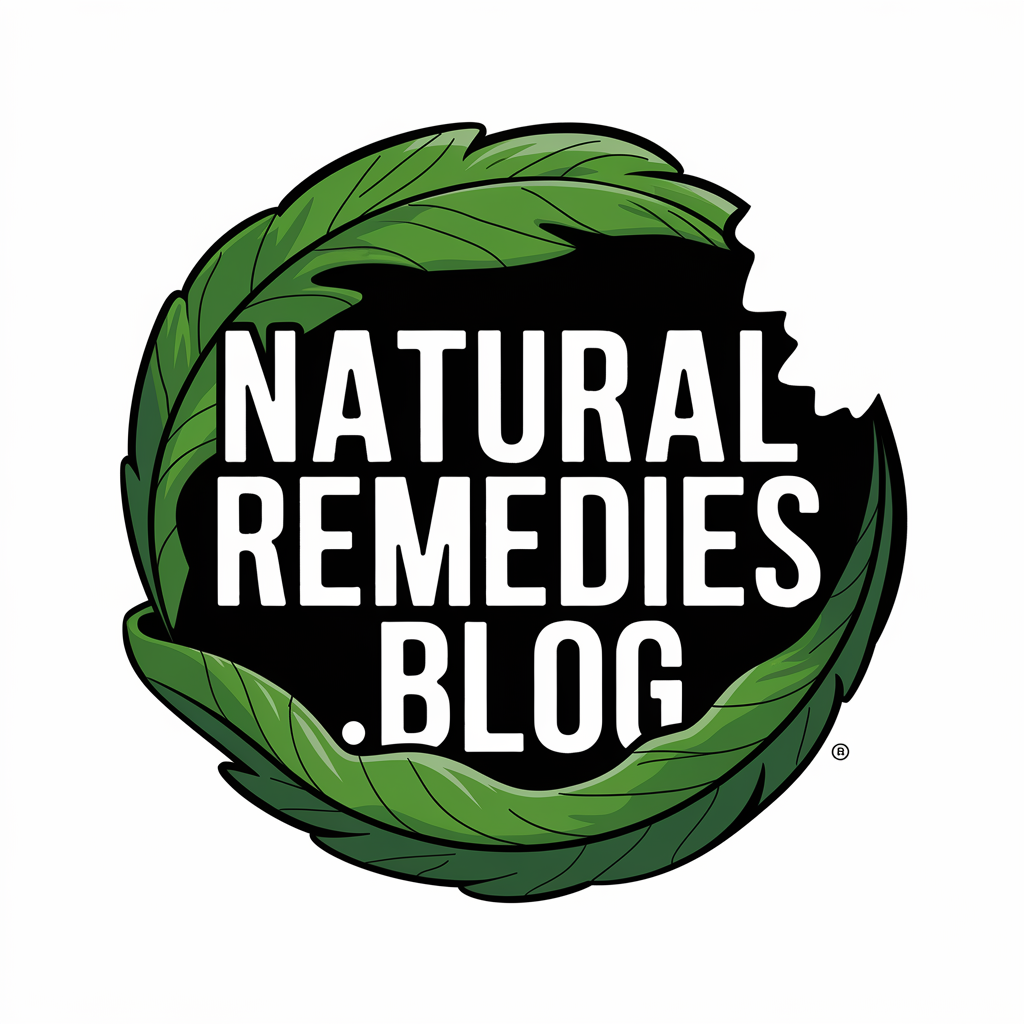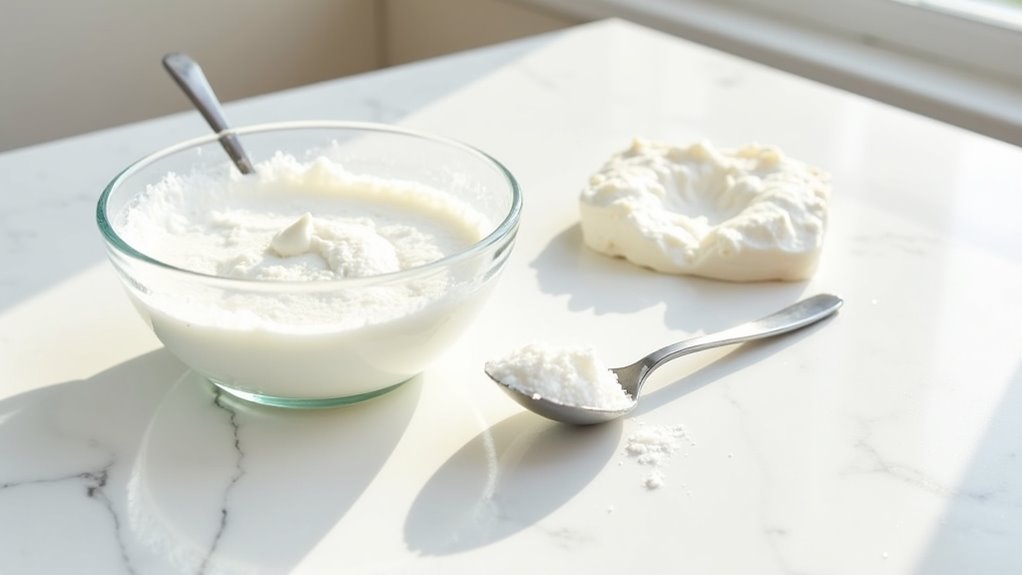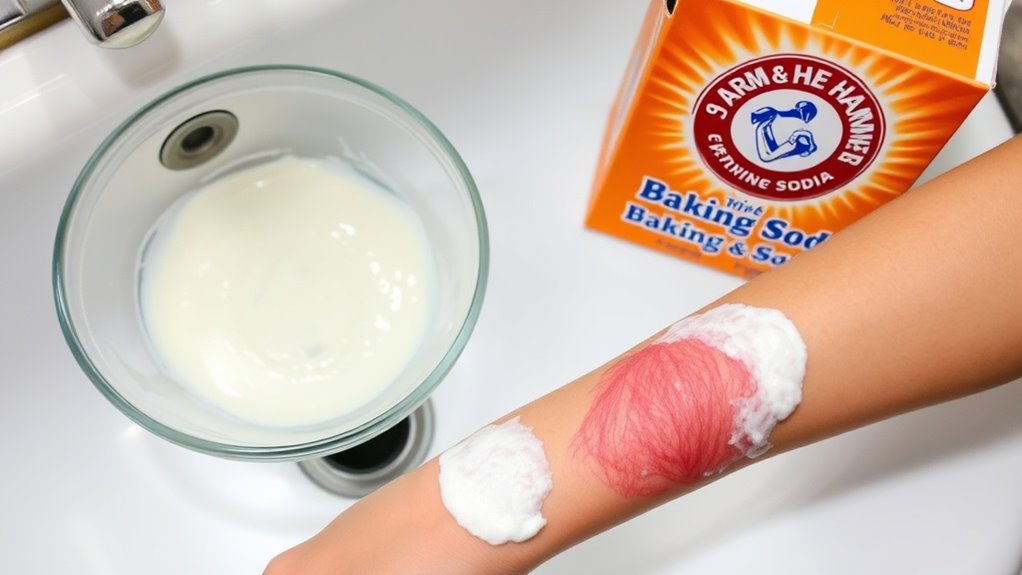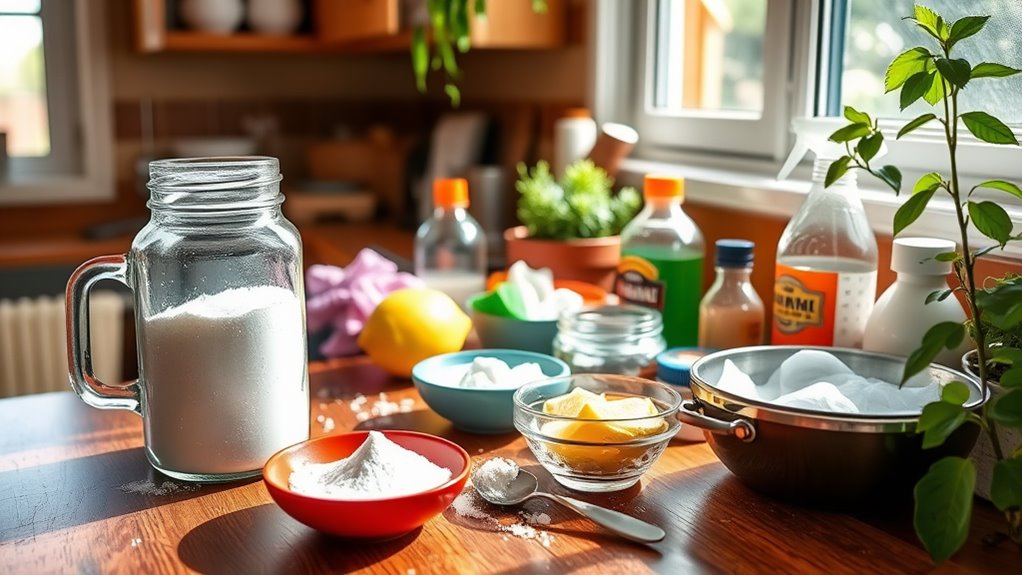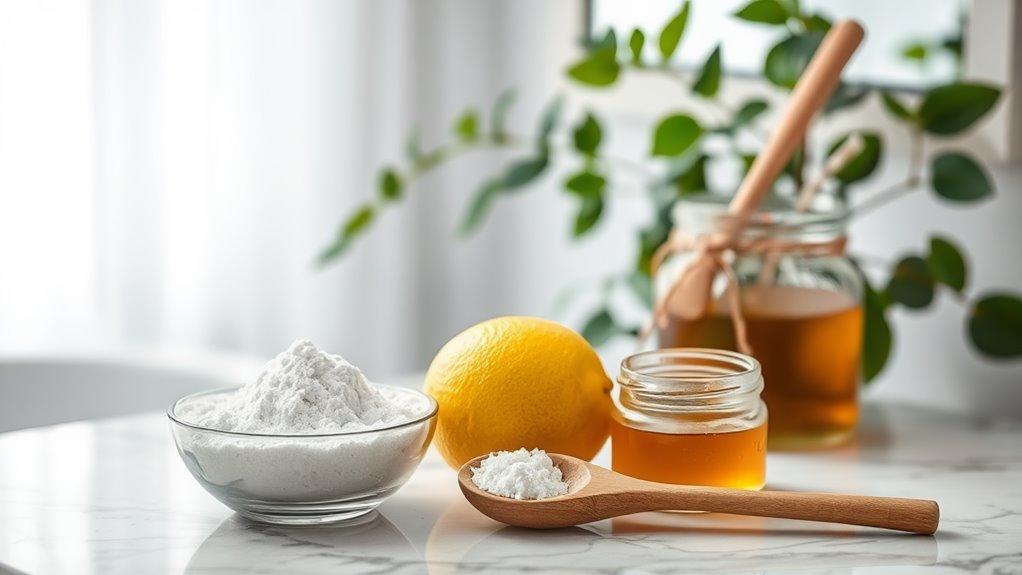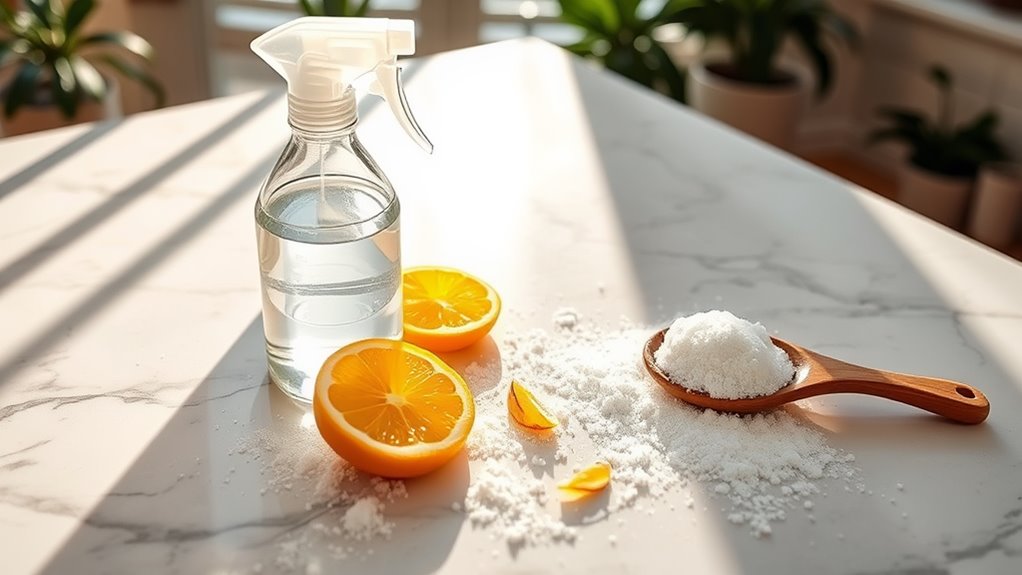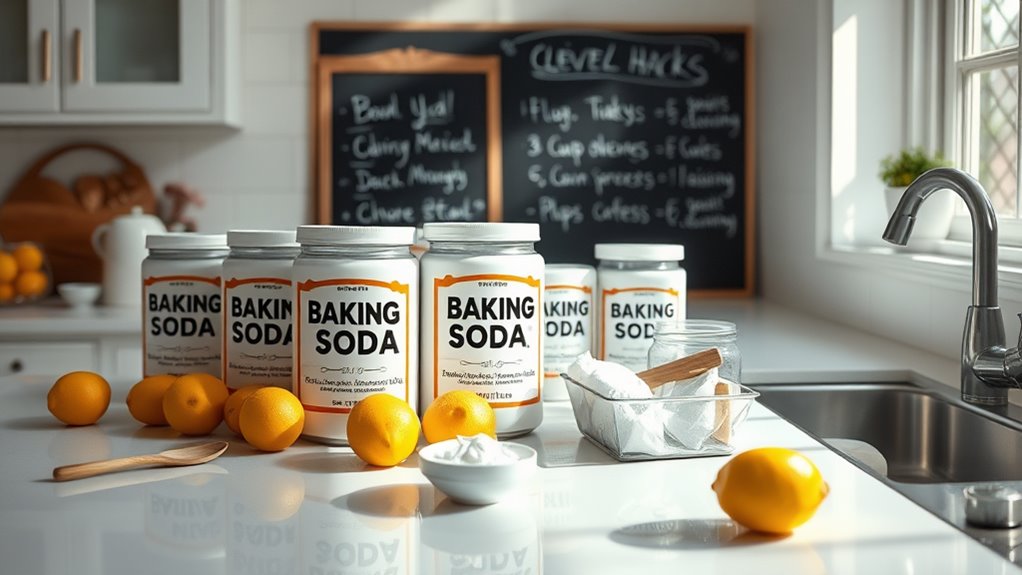Best Baking Soda Hack for Glowing Skin at Home
For glowing skin, mix 1 teaspoon of baking soda with 2 teaspoons of filtered water to create a smooth paste. Apply gently in circular motions, avoiding eyes and lips, then rinse with cool water. While this mild exfoliant can brighten your complexion, its high pH level (9.0) can disrupt your skin’s natural barrier. Limit use to once weekly and always perform a patch test first. Follow proper guidelines to maximize benefits while protecting your skin’s delicate balance.
What Makes Baking Soda a Skincare Wonder
While baking soda’s alkaline properties and fine texture have made it a popular DIY skincare ingredient, dermatologists caution against its widespread use on facial skin.
When you apply a baking soda face mask, its pH level of 9 can disrupt your skin’s natural acid mantle, which typically maintains a pH between 4.5-5.5. This disruption can lead to increased sensitivity, dryness, and inflammation.
Though baking soda’s mild abrasive qualities may temporarily remove dead skin cells, its high alkalinity can damage your moisture barrier and beneficial bacteria, potentially causing long-term skin problems.
Essential Ingredients for Your DIY Face Mask
After understanding the risks of baking soda on facial skin, it’s important to focus on scientifically-backed ingredients that support your skin’s natural balance.
You’ll need specific ingredients to create an effective, pH-balanced face mask: raw honey for its antimicrobial properties, aloe vera gel to soothe inflammation, and plain yogurt containing natural lactic acid.
Mix these gentler alternatives with nutrient-rich additions like vitamin E oil or colloidal oatmeal.
If you’re considering baking soda, dilute it significantly—using no more than 1/4 teaspoon per two tablespoons of base ingredients.
Always patch test new ingredients and discontinue use if irritation occurs.
The amphoteric compound properties of baking soda can help normalize your skin’s pH when used correctly in minimal amounts.
Step-by-Step Mixing Instructions
Creating a safe and effective DIY face mask requires precise measurements and proper mixing techniques.
Start by measuring 1 teaspoon of baking soda into a clean glass bowl. Add 2 teaspoons of filtered water gradually while stirring with a non-metallic spoon. Mix until you’ve achieved a smooth, paste-like consistency without lumps.
Don’t make the mixture too watery, as it won’t adhere properly to your skin.
Test the pH by applying a small amount to your inner wrist. If you experience any burning or irritation, rinse immediately and discontinue use.
For those with sensitive skin types, consider adding a teaspoon of raw honey to provide extra soothing benefits.
Patch Test Safety Guidelines
Before applying any new skincare treatment to your face, it’s essential to conduct a proper patch test to prevent potential adverse reactions. Apply a small amount of the baking soda mixture to your inner forearm and monitor for 24 hours.
| Warning Signs | Safe Signs |
|---|---|
| Redness | No changes |
| Itching | No discomfort |
| Swelling | Skin remains normal |
If you experience any adverse reactions, discontinue use immediately and rinse thoroughly with cool water. Those with sensitive skin or existing skin conditions should consult a dermatologist before trying this treatment. Remember, baking soda’s alkaline nature can disrupt your skin’s natural pH balance.
Application Techniques for Best Results
To achieve optimal results with a baking soda facial treatment, proper application technique is crucial.
Mix one part baking soda with three parts filtered water until you’ve formed a smooth paste. Using clean fingertips, apply the mixture in gentle circular motions, avoiding the eye area and lips.
Don’t scrub aggressively, as this can cause micro-tears in your skin. Leave the paste on for no more than 2 minutes, as extended contact may disrupt your skin’s pH balance.
Rinse thoroughly with cool water, then immediately apply a pH-balancing toner and moisturizer to protect your skin barrier.
For enhanced benefits, consider adding raw honey to your mixture which can provide additional moisturizing properties while helping prevent irritation.
How Often to Use the Face Mask
While baking soda masks can offer exfoliating benefits, you shouldn’t use them more than once per week due to their potentially harsh effects on your skin’s protective barrier.
For optimal skin health and to prevent irritation, follow these evidence-based guidelines:
- Wait at least 7 days between baking soda mask applications.
- Discontinue use if you experience redness, burning, or increased sensitivity.
- Reduce frequency to bi-weekly if you have sensitive or reactive skin.
- Never apply the mask on broken skin, active acne, or during a breakout.
Monitor your skin’s response and adjust usage accordingly to maintain your natural pH balance.
The mask’s alkaline pH level of 9 can disrupt your skin’s natural barrier if used too frequently.
Benefits and Expected Outcomes
When you use a baking soda face mask correctly, you’ll notice gradual skin brightening effects within 2-3 applications due to its mild exfoliating properties.
Clinical studies suggest that baking soda’s alkaline pH helps remove dead skin cells and surface impurities, though you should monitor your skin’s response carefully.
You can expect to see improvements in skin tone within 1-2 weeks of consistent use, provided you follow the recommended frequency and don’t experience any sensitivity.
For optimal results, combining baking soda with natural moisturizing ingredients like honey or coconut oil can help prevent excessive dryness while maintaining its exfoliating benefits.
Natural Skin Brightening Effects
Baking soda’s natural alkaline properties can create a temporary brightening effect on your skin by gently exfoliating dead cells and balancing pH levels. When used properly, this mild abrasive agent works to enhance your skin’s natural radiance.
-
The sodium bicarbonate crystals break down surface melanin deposits, reducing the appearance of dark spots.
-
Its pH-balancing effect helps normalize oil production and minimize dullness.
-
Microdermabrasion-like action removes built-up debris that causes skin to appear lackluster.
-
The alkaline nature temporarily tightens pores, creating an immediate brightening effect.
Remember to perform a patch test first, as baking soda’s alkalinity can be harsh for sensitive skin.
Fast and Safe Results
The speed and effectiveness of baking soda’s skin-brightening properties make it an attractive option for those seeking quick improvements. You’ll notice initial results within 5-10 minutes of application, with optimal effects developing over 2-3 weeks of consistent use.
| Timeline | Expected Results | Safety Notes |
|---|---|---|
| 5-10 mins | Immediate glow | Watch for sensitivity |
| 24 hours | Reduced dullness | Limit exposure time |
| 1 week | Even skin tone | Use gentle pressure |
| 2 weeks | Decreased spots | Monitor reactions |
| 3 weeks | Refined texture | Don’t exceed twice weekly |
Remember to perform a patch test and maintain proper dilution ratios to avoid potential irritation while achieving your desired results.
Precautions and Side Effects
Before applying baking soda to your face, you’ll need to perform a patch test on a small area of skin to check for potential sensitivity or adverse reactions.
If you experience redness, burning, itching, or any discomfort during use, discontinue immediately as these are warning signs of skin irritation or an allergic response.
You shouldn’t use this treatment more than once or twice per week, as overuse can disrupt your skin’s natural pH balance and protective barrier, leading to inflammation and increased sensitivity.
Similar to treating canker sores with benzocaine, discontinue use if you experience any numbness or tingling sensations.
Skin Type Sensitivity Tests
While baking soda’s alkaline properties can benefit some skin types, performing a patch test is crucial before applying it to your face.
To determine if you’re sensitive to baking soda, follow these essential steps:
- Mix a small amount of baking soda with water to create a thin paste.
- Apply the mixture to a quarter-sized area on your inner forearm.
- Wait 24 hours and monitor for any adverse reactions like redness, itching, or burning.
- If irritation occurs, don’t use baking soda on your face.
If you have sensitive, acne-prone, or rosacea-affected skin, consult a dermatologist before trying this treatment.
Overuse Warning Signs
Despite baking soda’s potential skincare benefits, overusing it can seriously damage your skin’s protective barrier and disrupt its natural pH balance.
Watch for signs of irritation like redness, burning, itching, or unusual dryness. If you notice increased sensitivity to skincare products, flaking, or a tight, uncomfortable feeling after washing, you’re likely overdoing it. These symptoms indicate compromised skin barrier function.
Stop using baking soda immediately if you experience breakouts, inflammation, or persistent redness.
Long-term overuse can lead to chronic dryness, premature aging, and hyperpigmentation. Never use baking soda on broken skin or active acne lesions.
Potential Allergic Reactions
Some individuals may experience severe allergic reactions when applying baking soda to their skin, ranging from mild contact dermatitis to painful chemical burns.
If you’re using baking soda on your skin, watch for these warning signs of an allergic reaction:
- Sudden redness, itching, or burning sensation immediately after application
- Development of hives, welts, or raised patches within minutes to hours
- Swelling around the eyes, lips, or throat – a sign of potential anaphylaxis
- Difficulty breathing or tightness in chest, requiring immediate medical attention
Always perform a patch test 24 hours before full application.
Storage and Shelf Life Tips
Proper storage of baking soda is crucial to maintain its effectiveness for skincare use. Keep your baking soda in an airtight container away from moisture, heat, and direct sunlight.
Don’t store it in the bathroom, as humidity can cause clumping and decrease potency.
While baking soda doesn’t technically expire, it can lose its effectiveness over time. You’ll want to replace it every six months for optimal skincare results.
To test if it’s still active, mix a small amount with vinegar – if it fizzes vigorously, it’s still good to use. Always check the manufacturing date before purchasing new boxes.
Complementary Natural Ingredients to Enhance Results
While baking soda works well on its own, combining it with other natural ingredients can amplify its skin-brightening effects.
Scientific research supports the benefits of these complementary ingredients when mixed with baking soda:
-
Honey – Contains natural antibacterial properties and helps retain moisture while preventing overdrying
-
Lemon juice – Rich in vitamin C and citric acid that aids in natural exfoliation
-
Apple cider vinegar – Balances skin pH and contains beneficial alpha-hydroxy acids
-
Plain yogurt – Provides lactic acid and probiotics that support skin barrier function
For enhanced moisturizing benefits, consider adding coconut oil which contains lauric acid that helps combat skin infections.
Always patch test combinations first, and don’t exceed recommended concentrations to avoid potential irritation.
